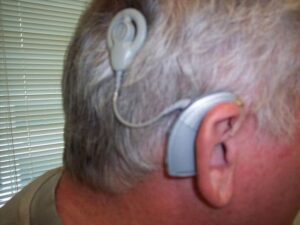By: Judy Huch and Jennifer Lamfers
The fact that electrical stimulation can produce auditory sensation is not new; this information has been around since the 1700s. However, it wasn’t until 1957 that speech understanding through electrical stimulation was demonstrated{{1}}[[1]]Osberger, M.J. & Koch, D.B. Cochlear implants. In R.E. Sandlin (Ed.), Textbook of Hearing Aid Amplification, 2nd ed. (pp. 673-703). San Diego: Singular Publishing Group, Inc.[[1]]. Cochlear implant systems are made up of internal and external components. The external portion, worn over the ear similarly to a behind-the-ear hearing aid, consists of a microphone, a speech processor and a transmitter that sends the signal to the internal portion. The internal component is made up of a receiver and an electrode array, which stimulates the cochlea with electrical current.
Since the inception of cochlear implantation in the U.S. there have been great strides in internal electrode arrays. The first cochlear implant had only one electrode and offered very little in the way of sound discrimination. Cochlear implants today have up to 32 electrodes and stimulate different frequencies or pitches within the cochlea offering the patient a greater depth of sound.
Many people are aware that these devices, when implanted in early childhood, can help children with profound hearing loss to develop more normal speech and language. What most people don’t know is that the geriatric population can also benefit greatly from cochlear implants. Under FDA criteria, patients of any age with profound sensorineural hearing loss and very poor word discrimination (less than 40% in the better ear) are candidates for a cochlear implant. Candidacy was covered very well in our “Hearing and Kids” blog by Jane Madell, “Who Needs a Cochlear Implant?” Cochlear implantation is done as an outpatient procedure under general anesthesia. The whole surgery takes only 60-90 minutes. Studies show that for patients aged 65 and above, quality of voice improved between 76% and 87% and quality of life improved between 84% and 86% {{2}}[[2]]Buchman, C.A., Fucci, M.J., & Luxford, W.M. (1999). Cochlear implants in the geriatric population: benefits outweigh risks. ENT- Ear, Nose & Throat Journal, 78(7), 489-494.[[2]]. 
Our offices refer out for cochlear patients and we do the activation and programming for three of the cochlear implant companies. Our oldest patient to be implanted thus far is 86 years young! She is doing very well with the implant and the rehabilitation that follows.
Jennifer Lamfers, AuD, first worked on this information for our “Physician education” to help spread the word to our referring physicians that there are more options than just hearing aids, and sometimes we need their help for cochlear implants for their patients. Audiologists can not order supplies for cochlear implant patients and/or sign certificates of medical necessity (CMN) and letters of medical necessity (LMN). That, in our opinion (Judy Huch and Jennifer Lamfers the authors), slows up the process and adds layers to getting the implants on individuals.
Jennifer Lamfers is originally from Miami, and acquired her undergraduate degree at The Florida State University. She moved to Phoenix for graduate school and completed her Clinical Doctorate in Audiology in 2010 at A.T. Still University-Arizona School of Health Sciences. There she focused on amplification, pediatrics and vestibular testing. She has annually attended a Rotary Club medical mission trip “Ayúdeme a Escuchar” (“Help me to hear”) in Guaymas, Sonora, Mexico.






